Helping Hiroshima
Moral Adoption Program
At the time of the bombing, most elementary school children in the 3rd to 6th grades were evacuated in groups from the city. They were saved, but many lost all their relatives.
Norman Cousins visited Hiroshima and published a report in the Saturday Review of Literature, of which he was chief editor. In that article, he introduced the idea of moral adoption, a system by which people overseas could contribute to the wellbeing of a single A-bomb orphan. It was not a legal adoption but a way of offering ongoing supplies and money.
On December 20, the sum of $2,000 (then, 720,000 yen) was sent to the mayor of Hiroshima. It was distributed to eligible children in the Hiroshima War Orphans Foster Home. Through this movement, approximately 500 children received assistance.
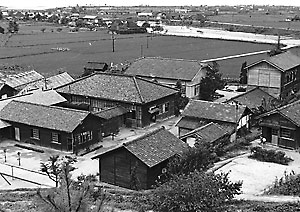 33 Establishment of the Hiroshima War Orphans Foster Home August 1947 Hiroshima War Orphans Foster Home Itsukaichi-cho, Saeki-gun Photo by Shunkichi Kikuchi A reception center for war orphans was first established right after the bombing on August 10, 1945, in Hijiyama Elementary School. On December 23, 1945, the Hiroshima War Orphans Foster Home was established in Itsukaichi-cho, Saiki-gun, in order to provide a home for evacuated children who had lost parents and relatives. |
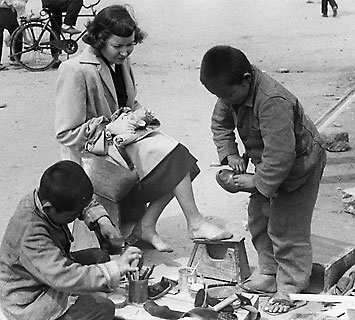 34 Shoeshine children 1948 In front of Hiroshima Station Photo by Yuichiro Sasaki Courtesy of Yugo Shioura Many children who lost their parents and siblings due to the A-bomb, and many others who became separated from their family due to the difficult living conditions afterwards would shine shoes to scrape out a living. |
 35 Norman Cousins holding an adopted child January 9, 1951 Ninoshima Island Ninoshima Gakuen Courtesy of Chugoku Shimbun The Moral Adoption Program was started with donated funds being sent to the Hiroshima War Orphans Foster Home, and was expanded in 1950 to include other institutions such as the Ninoshima Gakuen and Shinsei Gakuen. The Saturday Review of Literature coordinated the program in the United States and later the Hiroshima Peace Center Associates in USA took over that role. |
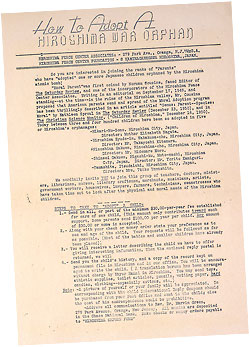 36 Moral Adoption Program flier Courtesy of Chisa Tanimoto The Hiroshima Peace Center Associates in USA publicized the Moral Adoption Program and sought out contributions. The flier appeals to all walks of life including teachers, doctors and housewives, and explains the adoption process. |
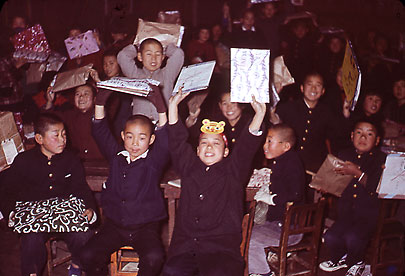 37 Children made happy by a donated present 1953 Courtesy of Chisa Tanimoto The exchanges between American parents and the children took the form of letters and presents with clothing, stationery, gloves and similar items being donated |
 38 A child sadly says goodbye to his foster parent visiting Hiroshima October 1953 Courtesy of Chugoku Shimbun Some foster parents came to Hiroshima to visit their adopted children. The program greatly helped the children through difficult times with some children continuing to exchange letters even after they were grown and no longer receiving donations. |
||
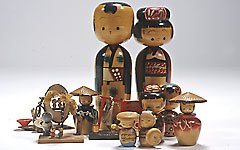 39  40 |
Dolls and rice paddle
Dolls and rice paddle Donated by Dorothy J. Blackman The donor, Dorothy Blackman, joined the moral adoption program through a local woman's organization. She sent letters and presents to the child she adopted. In return, the child sent her dolls, a rice paddle, and the like. |
||
 41 Overseas family Courtesy of Chisa Tanimoto As there were many Americans with feelings of guilt for the A-bomb who sought atonement, there were likewise many who wanted to become foster parents. |
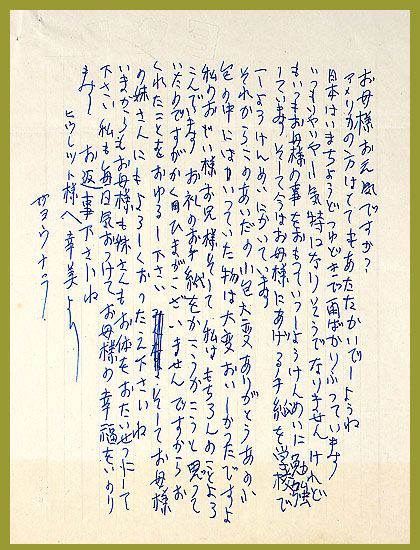 42 Letter from a child to her parents |
